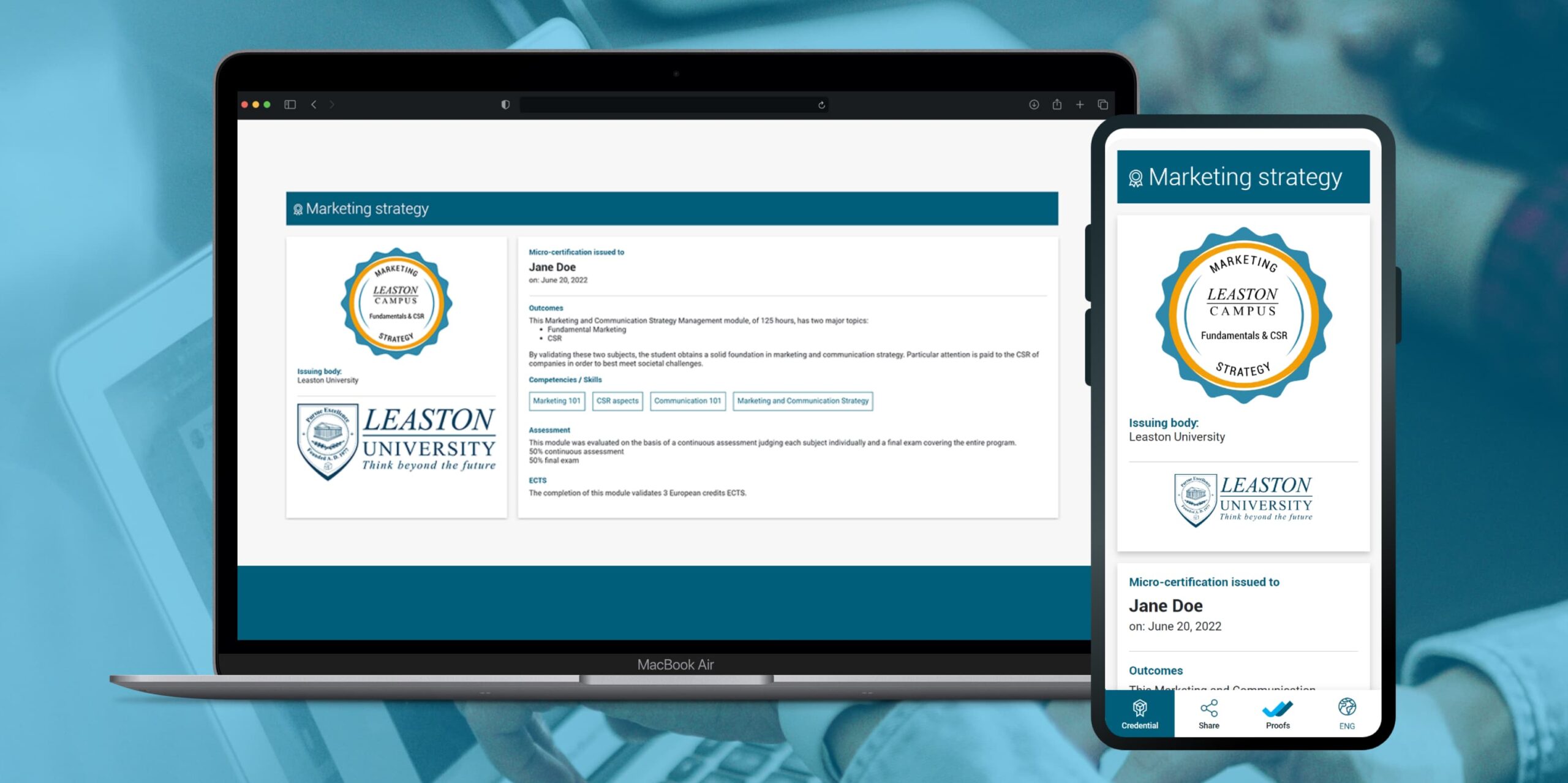In a world of rapid technological change, the demand for targeted and verifiable skills is at an all-time high. Traditional degree programs are no longer the only path to professional success. Enter micro-credentials, a transformative approach to education and workforce development. This guide offers a comprehensive overview of these focused qualifications, their benefits, and their growing significance for certifying organizations.
What exactly are micro-credentials?
These focused qualifications represent a verifiable acknowledgment of a certain aptitude. They are designed to be smaller and more targeted than academic degrees, offering a flexible and efficient way for people to acquire and demonstrate new capabilities. For educational institutions and training organizations, they are a powerful tool to meet the needs of enrollees and companies, offering a modern way to certify achievement.
Definition and key characteristics
A micro-credential is a certification that verifies an individual has mastered a particular competency or set of competencies. These awards are issued after a short, focused educational experience and a corresponding assessment. Key characteristics include their narrow focus, their basis in demonstrated ability rather than time, and their digital nature, often represented by an online badge. They are a formal recognition of acquired know-how and are increasingly offered by universities, colleges, and other training providers.

How they differ from degrees, certificates, and badges
While related, these short-form certifications differ from other forms of recognition. A traditional degree represents a broad field of study over several years. A certificate initiative is typically longer than a micro-credential but shorter than a degree, covering a wider subject area. A digital badge, on the other hand, is the online representation of a qualification. The badge is the verifiable record, while the micro-credential is the achievement it signifies. Unlike some badges for simple participation, a micro-credential badge proves successful assessment of a particular aptitude, and the focus is generally on job-relevant expertise.
Industries and professions that benefit most
The application of focused qualifications spans many industries. The tech sector relies on them heavily to verify skills in particular programming languages or software. Healthcare professionals use them for specialized procedures or technology. Educators are also using them for their own professional advancement, involving, for example, the mastering of new teaching methods. Any profession undergoing rapid change will find value in the targeted development offered by these awards, which help support career growth.
How micro-credentials work
The process of earning and issuing these awards represents a departure from traditional educational models. It is rooted in demonstrating what a person can do. For certifying organizations, understanding this process is key to their successful implementation.
The step-by-step earning process
The journey to earning a micro-credential starts with an individual identifying a certain aptitude to develop. They enroll in a relevant online course or initiative offered by a university, college, or other provider. This offering will have a clear curriculum focused on the target competency. The participant engages with the instructional materials, and must pass an assessment to prove mastery. Upon success, the institution issues the qualification, often as a secure digital badge. This process offers a clear path to gaining a new, verifiable expertise.
Competency-based learning explained
At the heart of micro-credentials is competency-based instruction. This educational model focuses on outcomes rather than on the time a student spends studying a particular subject or field. Participants progress by demonstrating mastery of a certain ability, regardless of how long it takes. This approach allows for personalized paths, where individuals can move quickly through familiar material, and focus more on particularly challenging areas. This is a significant shift from the credit-hour model, focusing instead on what individuals know and can do, ensuring that they have the necessary target capabilities for the job market.
Digital badges and credential verification
A key component of the micro-credential ecosystem is the digital badge. These are not just images, they are verifiable, portable, and contain detailed metadata. This data includes the issuing institution, earning criteria, expertise, and sometimes evidence of the person’s actual work. This makes it easy for hiring managers to verify the authenticity of a claim to a particular ability, which is crucial for building trust in the award.

Top benefits of pursuing micro-credentials
The growing popularity of these qualifications stems from the advantages they offer to recipients, educators, and employers. For organizations, understanding these benefits is crucial for communicating their value.
Career advancement and salary potential
For many professionals, micro-credentials are a direct route to career advancement. By acquiring in-demand capabilities, individuals can qualify for promotions, or transition to new roles. This up-skilling can also lead to an increased salary potential. Companies are often willing to pay a premium for role candidates who can demonstrate certain, cutting-edge competencies. A focused qualification provides a verifiable proof that links instruction directly to professional growth.
Recognizing a learner’s success and a program’s growth
Issuing micro-credentials allows an educational or training institution to formally recognize the targeted expertise their students or trainees have mastered. This granular recognition of achievement is highly motivating for individuals, and provides tangible evidence of their success. For the institution, this offers a new way to showcase the effectiveness of its offerings. Tracking the success of people who have earned these awards can demonstrate a curriculum’s relevance and support its growth. The rise of micro-credentials in educational and training contexts is a testament to this trend.

Personalized learning paths
Micro-credentials empower individuals to create personalized educational and training journeys aligned with their career goals. Instead of a lengthy, one-size-fits-all degree, students and trainees can select targeted courses and qualifications to fill their knowledge gaps. This flexibility allows for a more tailored and relevant experience. For educators, this means offering a more diverse curriculum that can cater to a wider range of needs.
Cost and time efficiency compared to traditional education
A significant benefit of micro-credentials is their cost and time efficiency. Compared to the investment required for a traditional degree, they offer a more accessible alternative. The focused nature of the instruction means people can acquire valuable expertise more quickly and at a lower cost. This makes professional development more attainable for a broader audience, including working professionals.
Why micro-credentials matter in today’s job market
The modern economy demands specific, adaptable abilities. Micro-credentials are uniquely positioned to address this. They are a critical tool for bridging the gap between education and employment.
Addressing skill gaps quickly
Industries are evolving rapidly, creating skills gaps in the workforce. Traditional education can be very slow to adapt. Micro-credentials offer a nimble solution. They can be developed and deployed quickly to address emerging needs, ensuring the workforce has the up-to-date capabilities companies seek. This rapid response is essential for maintaining a competitive edge.
Flexibility for working professionals
For those already in the workforce, finding time for professional development is a challenge. Micro-credentials offer the needed flexibility. Many offerings are online and self-paced, allowing individuals to study when it is convenient. This accessibility empowers working professionals to continuously upgrade their abilities and stay relevant without putting their careers on hold.
Employer recognition and industry trends
Hiring managers are increasingly recognizing the value of micro-credentials. They provide a clear signal of a candidate’s specific capabilities. Many companies now actively seek candidates with more relevant qualifications, and are partnering with education providers to develop custom initiatives. This growing industry acceptance is a key driver of the micro-credential movement. It is therefore becoming more and more important for providers to know how to choose the right micro-credential platform to guarantee their relevance in the market.

How to choose the right micro-credential program
With the proliferation of offerings, it is essential to select high-quality initiatives that deliver real value. Careful evaluation is key.
Accreditation and reputation of providers
Not all short-form certifications are created equal. The credibility of the issuing institution is paramount. Individuals should look for offerings from reputable universities, colleges, or industry-recognized organizations. Accreditation is a key indicator of quality, signifying that the curriculum has met rigorous standards. The provider’s reputation will impact how a qualification is perceived by the industry, and the right credentialing platform will guarantee the reliability of the ecosystem.
Alignment with career goals
A micro-credential should be a strategic career investment. Before enrolling, individuals should understand their goals, and how specific expertise will help achieve them. Researching job market trends to identify in-demand competencies is a crucial step. The curriculum should directly align with the capabilities needed for career advancement in the evolving market.
Evaluating costs and ROI
While generally affordable, micro-credential costs can vary. It is important to evaluate tuition and any additional fees. This should be weighed against the potential return on investment (ROI). The potential for salary increases, career opportunities, and the acquisition of valuable, long-term abilities need to be considered. A thorough cost-benefit analysis will help ensure an offering is a worthwhile investment for both credential issuers and earners.
Create a relevant micro-credentials program with BCdiploma
For institutions or training providers aiming to meet these criteria of quality, relevance, and transparency, BCdiploma offers a robust, end-to-end platform for designing and issuing trusted micro-credentials.
Built around the principles of skill recognition and learner-centric pathways, the solution enables organizations to structure their credentials according to clear learning outcomes, competencies, or professional standards—ensuring alignment with both industry expectations and learner goals.
Each micro-credential issued with BCdiploma includes rich, customizable metadata, offering full context on the skill acquired, assessment methods, credit value, issuing body, and links to further learning. Credentials are secured on the blockchain and instantly verifiable, reinforcing trust for recruiters and institutions alike.
With native LMS integration (via API or tools like Zapier), automated issuance, and a visual design studio for creating branded, modular templates, BCdiploma helps institutions streamline deployment while enhancing learner experience. The platform also supports stackable credentials and modular learning pathways, enabling learners to progressively build toward broader certifications—a key feature in today’s evolving professional landscape.
Frequently Asked Questions
How long does it take to earn a micro-credential?
The time to earn a micro-credential varies. Generally, they are much shorter than traditional academic courses. Some can be completed in weeks, while others might take a few months of part-time study. The competency-based nature means participants who master the material quickly may finish sooner.
Can micro-credentials replace a degree?
Currently, these focused qualifications are a complement to a degree, not a replacement. A degree provides a broad knowledge foundation, while a micro-credential offers specialized, job-specific expertise. The ideal combination for many is a degree supplemented by a portfolio of these awards. However, for certain career pivots, a series of targeted qualifications may be a viable alternative to a second degree.
Do employers value micro-credentials?
Yes, industry recognition of micro-credentials is on the rise. Many companies see them as reliable evidence of a candidate’s particular abilities. The value is often tied to the provider’s reputation and the relevance of the competency to the role or field. As more companies integrate these awards into their hiring processes, their value in the job market will continue to grow.
How can micro-credentials be showcased on resumes and LinkedIn?
Micro-credentials, especially as digital badges, are easy to share. On a resume, they can be listed in a ‘Professional Development’ or ‘Certifications’ section, with the name, issuer, date, and a clickable link. On LinkedIn, digital badges can be added to the ‘Licenses & Certifications’ section. This allows potential hiring managers to view and verify the qualification with a single click, providing immediate access to the details of the achievement.
